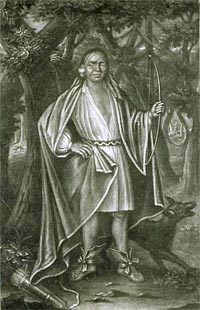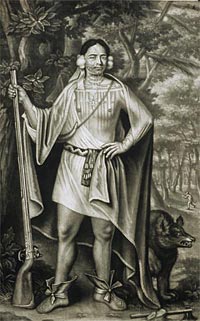Page content
John Montour
- Native American linguistic and cultural interpreter
- Born in 1744, one of nine siblings
- Attended the Brafferton Indian school at the College of William & Mary
- Adapted tactics to survive several colonial conflicts
- Murdered on hunting trip in 1788
Birth and family
John Montour was born in 1744. His father was Andrew Montour, a well-known Métis who had Iroquois and French ancestors. His mother was a Delaware, the granddaughter of Sassoonam. Andrew Montour married twice and possibly three times.
Late in the Revolutionary War, reports indicated that John was one of seven brothers or half-brothers. The English names of two are known: Debby, who was schooled in Philadelphia, and Thomas, who was killed during the Revolution. John Montour also had at least two sisters. Kayodaghscroony, or Madelina, was living with the Delaware in 1756, and Polly was cared for in Philadelphia in the late 1750s and early 1760s.
Followed in his father’s footsteps
John’s father, Andrew Montour, was one of the most important interpreters and negotiators in the Virginia and Pennsylvania backcountry in the 1750s and 1760s. Authorities in New York, Pennsylvania, and Virginia employed his services. In the 1750s, Andrew Montour believed it was possible for go-betweens such as himself to truly live in both the Indian and white worlds, and he hoped that his children could too.
To that end, Andrew Montour enrolled his 10-year-old son in the Brafferton School at the College of William and Mary in 1754 and 1755. John received further education in Philadelphia. As a result of his schooling, Montour could both read and write English and speak it correctly. Undoubtedly, he could speak his native tongue, Delaware, and, because of his close dealings with the Wyandot and the Mingo during the Revolutionary War, he probably spoke those languages as well. Most important, after his many years living with Anglo-Americans, John Montour knew their ways well.
Career as an interpreter
In 18th century documents, men like John Montour are called interpreters, because they literally translated the speeches of each into the language of the other. But they did much more. They guided colonists to Indian villages and escorted Indian delegations to colonial capitals such as Williamsburg. They carried news from place to place. They would advise both sides of the cultural divide on what would be acceptable to the other. In other words, they were cultural go-betweens, brokers, mediators, and negotiators.
In the best of times, the cultural go-between was a true bridge between the Indian and colonial worlds. But tension between the two mounted during the 1750s, 1760s, and 1770s. As attitudes of distrust and contempt hardened, the role of the cultural go-between, who hoped to keep a foot in both camps, grew problematic, and perhaps, in the end, even impossible.
Career of contradictions
The strange wartime career of John Montour was a collection of inconsistencies. At times he found himself pro-British, anti-American; pro-American, anti-British; friendly with the anti-America Wyandot and anti-American Delaware Wolf clan, loyal to the discredited John Killbuck, a captain in the American army, a vengeful raider on the Pennsylvania frontier.
The nature of the Revolutionary War in the Ohio country provides some explanations. Very quickly, pre-war alliances among the Indians and between Indians and colonists collapsed. The war became what historian Richard White has labeled “a contest between villages, both Indian and white.” Under the constant pressure to choose sides, even villages fragmented into competing factions.
In this world of raids and counter raids and persistent apprehension, neutrality—the ability or desire to walk the middle course—was foreclosed. Yet such a space was essential for a cultural go-between. As the war progressed, John Montour’s room to maneuver between Indian and Americans disappeared.
Murdered in 1788
An account from American missionary John Heckewelder provides closure on Montour’s life. On a trip to visit the old Moravian settlements on the Muskingum, Heckewelder learned that two people he had known well had died. One was a Pittsburgh printer, who had hanged himself. The other was John Montour, who had been murdered by some Mingoes while he was out hunting in the winter of 1788. John Montour had made enemies; it was not surprising that he would die at the hands of Mingoes.
Despite Andrew Montour’s hope that his son would continue his dream and be at home in both the Indian and white worlds, it was not to be. John Montour remained at his cultural core an Indian. Sensitivity to slights, reciprocal loyalty to friends, but most importantly, the demands imposed by kin and clan obligations, drove Montour’s actions.
Learn more:


